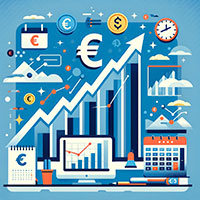When the Forex currency market began to form, transactions were conducted by telephone between institutional investors and dealers. Trading volumes were small, and pricing information was difficult to access. Modern technological appliances have radically changed the market. All trade is now conducted through computer networks, and dealers serve private customers in real time. Stream prices allow you to see the situation on the market at any time, and forex brokers provide access to trading for everyone. An important phenomenon has become the automation of the trading process. Computer programs can perform a specific sequence of actions on the market without human intervention.
What is an algorithm in forex trading
The algorithm is a sequence of actions recorded in the form of exact commands that are understandable to the performer and aimed at obtaining a result from the original data. In today's world, all currency exchange operations are performed by computers using human-controlled programs. That is, the operator sets the quantity, time and price of the application, and then the programs do everything themselves, interacting with each other. With the expansion of the international currency market and the increase in the number of transactions, algorithmic programs began to be introduced, replacing the manual labor of the operator.
For example, banks use algorithms to update quotes for currency pairs on trading floors. Algorithms significantly increase the speed of determining changes in market prices. Algorithmic programs are widely used by market makers to deliver liquidity to the market. Algorithms even caused a change in the market microstructure. Exclusively electronic execution of stock exchange actions was formed in the nineties of the last century, when the introduction of the decimal system necessary for algorithmic trading was carried out. As a result, the advantages of market makers have decreased, and the liquidity of the market has increased.
Attention! The robot can not rebuild itself. It works well in those periods when the market situation does not change, but once you do something unexpected, as the algorithm fails. When fundamental rather than technical factors come to the fore, the adviser continues to work in the same way, which is no longer effective under new market conditions. The adviser's profitability decreases when unexpectedly good or bad economic data are published, when political changes occur in the country, when natural disasters occur, which also affect the exchange rate, and so on. In these cases, a sharp human mind is much more preferable.
Development of algorithms
In the process of automating market processes, new trading algorithms have emerged that take into account prices simultaneously on multiple exchanges. Computers completely replaced human data processing. The scale of electronic trading has reduced commissions, has contributed to the merger of brokerage companies and the consolidation of financial markets. The market of Forex fundamentals that we see now is the result of computerization and the development of trading algorithms.
The exchanges are constantly competing in the struggle for the highest rate of order execution. Back in 2007, the TradElect system was launched on the London Stock Exchange with order execution for 10 milliseconds and processing 3,000 orders per second. Gradually, a speed of 3 milliseconds was reached, and today it is not uncommon for orders to be executed in one millisecond. Such qualitative changes made algorithmic trading possible for institutional and private traders. About 50% of stock trading is conducted by algorithms. The same trend has spread to the Forex market, where about 20% of orders are generated and executed by algorithmic programs.
Types of algorithmic trade
Any investment strategy of large traders can use algorithmic trading. Both partial support and full automation of the process are possible. Algorithmic trading is mainly used by large market participants, such as mutual and pension funds, hedge funds, and investment financial institutions. For the most part, the algorithm for splitting large bids is used. Institutional traders operate with large volumes, which is associated with the risk of loss. Too large volume of the order may not find a counterparty and a bargain price, and will also have an impact on the market.
Previously, the operation of splitting orders was performed manually, there even were companies that performed this work (execution services). In the beginning of XXI, algorithmic engines were created, performing the same actions that traders did. The trader sends a request to the "engine", selects the algorithm and controls the execution. Initially, algorithmic "engines" were developed and used only by leading brokers. As they improved and spread, large private clients gained access to algorithmic trading. Brokers call their engines differently, but by the principle of operation they can be divided into three main types.
The first, the simplest, consists in dividing a large order into equal parts and uniformly sending warrants to the market at the current price. This algorithm is designated by the English name TWAP. The work of this program is clearly visible in the order book, so its settings often change. The second algorithm, named VWAP, besides the division of orderes, takes into account the volume of trades during the day. And the third algorithm, called IceBerg, places small orders one by one, that is, market participants do not see the entire amount of a large application.
Attention! According to statistics, of the entire mass of trading robots offers on the Internet, only 10-15% are worthy, the rest is either non-working advisers or simply fraudulent schemes. Therefore, if you want to use a trading robot, then choose only those that are offered by reliable developers.
High frequency trade
Trading algorithms are mainly used to reduce the impact on the market and speed up the execution of orders. But there are those that are used for profit. The idea of ultra-fast trading on stock exchanges began in 1998, and in 2009, high-frequency algorithmic trading was called “HFT” - High Frequence Trading. Soon these technologies spread to the Forex market.
High-frequency trading has become possible through the use of powerful equipment, fast communication systems, combined with advanced software and special trading strategies. Transactions of purchase and sale are made in a split second. Algorithms analyze data, look for trading opportunities within the minimum price movement. Tens of thousands of trading operations are executed per day.
For a regular trader, high frequency trading is not available. This is done by investment funds, banks, financial companies. HFT operations capture an increasing part of the market. In fact, the game is ahead of the curve, the one who has faster algorithms earns more. Regulators tried to prove the illegal nature of HFT profits, but did not find formal reasons. In fact, HFT-traders have an advantage over the rest of the mass of market participants.
















